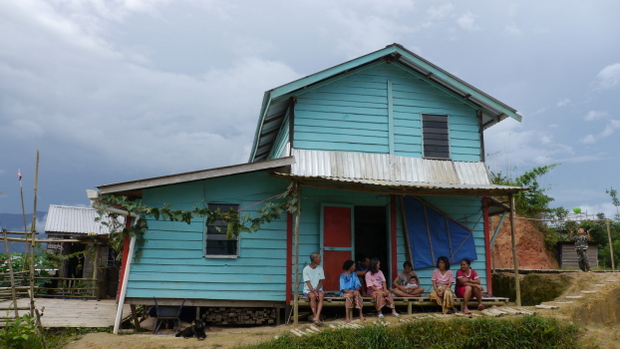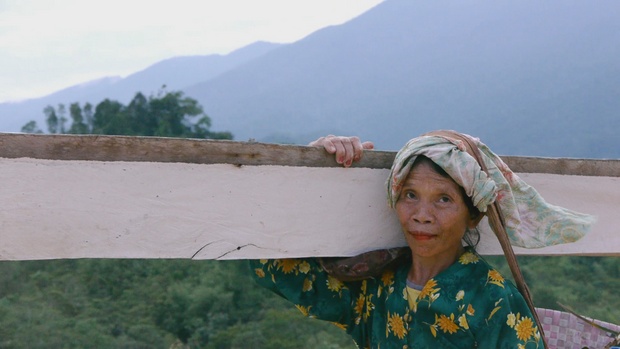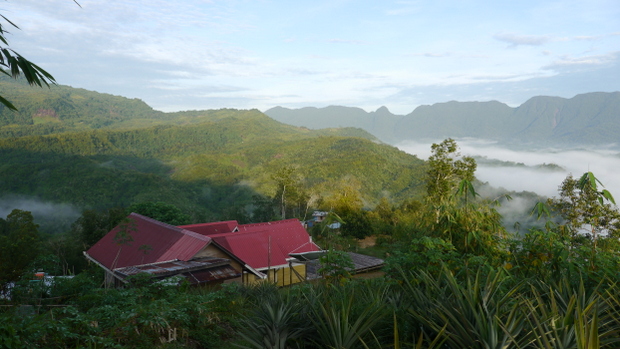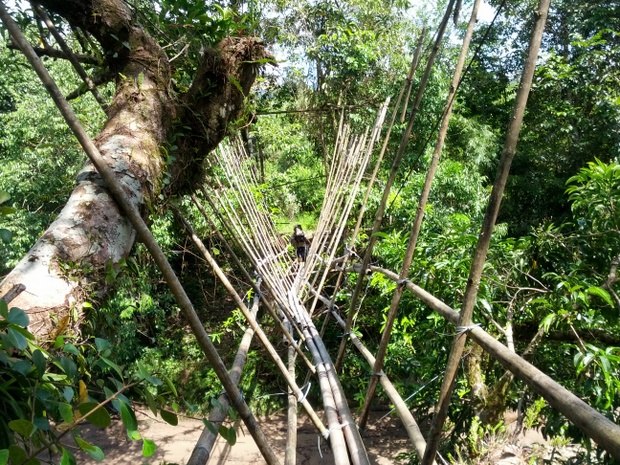In the Borneo Highlands of Sarawak, along the border between East Malaysia and Indonesia, warriors from Kalimantan would enter the ancestral homelands of the Bidayuh Tibiya, and raid the densely forested jungle for their heads. That was a long time ago. Their descendants, the Bidayuh of Upper Bengoh, no longer fear for their heads, but they do fear for their lands.
The Bidayuh, one of 40 sub-ethnic groups in Sarawak (of which 70 per cent of the entire population are of indigenous origin) found sanctuary within the Upper Bengoh escarpment, eventually settling into four kampungs, or villages: Rejoi, Taba Sait, Pain Bojong and Semban.
All up, over four centuries 12 settlements came and went. During that time the Bidayuh not only faced the Kalimantan warriors and inter-tribal wars, but the the reign of Charles Brooke the White Rajah (1841-1868) Japanese occupation (1941-1945), and British governance from 1946 up until Sarawak was granted independence in 1963.
Many indigenous communities enjoyed a brief period of respite in their forest homelands up until Sarawak's current Chief Minister Abdul Taib Mahmud took office in 1981. He wasted no time in establishing a vast local and international real estate empire financed by government contracts awarded to his family and affiliated companies: primary forest logging, bio-fuel and palm oil plantations, hydroelectric dams and water reservoirs. In doing so, Taib has presided over the eviction of thousands of Sarawak's first peoples off their ancestral lands.
Up until 2008 the Bidayuh in Rejoi, Taba Sait, Pain Bojong and Semban led relatively peaceful lives. That changed by mid-2008, when the government began construction of a water reservoir that would dam the Sarawak Kiri river.

The government wanted the Bidayuh off their land and preferably moved into a resettlement area on the outskirts of the capital, Kuching. Three villages would be inundated — Rejoi, Taba Sait and Pain Bojong. Semban was told their presence would contaminate the reservoir so they would have to leave as well.
Negotiations for compensation and relocation had barely begun when construction commenced. Some villagers were signing blank sheets of paper while others were marking documents with no explanation of their rights or the legal implications of what they were signing.
The residents of Rejoi, for example, were willing to leave their village if they were properly compensated and rights to their own land, given they moved to much higher ground, be acknowledged. Representatives of the government, alleged to be employees of the dam construction company, preferred to turn the villagers against one another.
By early 2009 Rejoi's community leader, Simo Anak Sekam, could not leave his village without a bodyguard. Along with Pain Bojong headman, Bodui Anak Dayu, they were turning their backs to the offer of resettlement outside of Upper Bengoh, wanting to stay on their own customary lands. Simo had received several threats which had been reported to his lawyer, See Chee How, and Kuching based NGO, SACCESS.
The government package being offered to the Bidayuh of Upper Bengoh stated that every household would be compensated for loss of their dwellings and farmland. The amount was determined by the size of their homes, sheds, storage areas and grounds, including what produce they were growing. They would also have to agree to move to a resettlement area, 10 kilometres away in Jalan Bau/Semadang. Houses would be built for them, which they would have to purchase. All up 1300 people would be displaced.
The compensation package was based on an arbitrary and haphazard assessment of Bidayuh assets, in spite of the detailed information recorded in the Bengoh Dam Environmental Impact Assessment (EIA). This wasn't clear to the villagers, nor did the compensation entirely cover the loss of land.
For example, Bodui said that he was compensated for dwellings and some of his crops, but not all the land they were grown on. He alleged that compensation for crops and other assets were valued according to outdated market rates.
The EIA, however, provided a thorough audit of all Bidayuh dwellings and farmlands, their produce and the number of family members per household. It also identified endangered flora, but neglected to take into account protected primates and bat species very much active in the catchment. Under Sarawak's Natural Resources and Environmental Ordinance of 1994, and the Wildlife Protection Ordinance of 1998, where endangered species were to be found no development would be supported there. But the Sarawak government has a long history of repudiating its own laws, ignoring native customary rights of indigenous people and employing thugs to terrorise them.

Sarawak's Government was not about to soften its approach in Upper Bengoh and many Bidayuh weren't ready to give up their lands for, as Simo said, “the pretty houses” and the “streets we cannot eat.”
By mid 2013 the dam has been completed, but the reservoir is yet to be filled. The process to impound Bidayuh lands continues. Rejoi and Pain Bojong have accepted the government's compensation package covering loss of their homes and farm lands, but they didn't take up the offer of resettlement.
If they did they would have had to find 95,000 Malaysian Ringgits (AUD$31,762) for an ordinary house and three acres of land per family. They chose instead to stay on their ancestral lands and move higher, well above the proposed water line that will inundate three of the Bidayuh villages when the reservoir is filled.
At considerable cost Rejoi and Pain Bojong packed up, stripped down their homes and resettled to where they could get mobile phone reception, which they couldn't at their previous settlements, and ample lands to nourish their families now and into the future.
They moved every plank, every sheet of roofing iron, every piece of furniture, every refrigerator, generator, gas canister, every single piece of infrastructure by hand, step by step, up perilous, muddy slopes, across bamboo bridges, way up onto the plateaus looking out over Bengoh.
In the intervening years they had served a summons and writ of claim for native customary rights over land that would, if approved, give them the legal right to stay put. Despite this, the Bidayuh are filled with uncertainty.
As their claim for rights to their own land makes its way slowly through Sarawak's overworked judicial system the Bidayuh were effectively served an eviction notice. On the 19 September this year the Minister for Planning and Environment, Abdul Taib Mahmud (also Sarawak's Chief Minister) issued a public notice appropriating approximately 5022 hectares of land, all of Upper Bengoh, for a national park. They gave the Bidayuh 60 days to contest the notification.
As beautiful as Upper Bengoh is, what national park values do Taib's kleptocrats want to uphold? The Bidayuh have farms throughout the escarpment – 62 and counting. Up to 14 per cent of the forest is regrowth, which See Chee How, the Kuching based lawyer working for the Bidayuh and contesting the notification, suggests it is likely a result of centuries of shifting cultivation. According to Chee How at least 80 per cent of the jungle is no longer primary forest.

Chee How believes the notice is a means to “chase the people away and grab their land.” In the Bengoh catchment EIA, it states:
"It is noted that Sarawak Land Custody and Development Authority proposed to develop a hill resort and agriculture station in the Penrissen Range, located south of the Bengoh catchment area. The development concept is base on quality ecotourism, with a 'cool and tranquil' theme, taking advantage of the local natural attraction such as its high elevation, cool climate and natural vegetation."
Chee How believes the government will eventually want to allow the development of hillside resorts there, bringing more harm to the environment than the few settlements now thriving in Upper Bengoh.
When asked how he felt about the new threat Simo told NM, “It's better to lose your head that lose your land. We are ready.”
As at the time of writing the Bidayuh are waiting to have their case heard in court. In the meantime a third settlement has risen to higher ground. The inhabitants of Taba Sait have re-established themselves in their new village Mookayung.

The new settlements of Nyegul, Sting and Mookayung , comprised of exactly 28 families each, remain to face Sarawak's criminal elite, defending their right to land and the self-sustaining lives they have created for themselves there.
The struggles of the Bidayuh typify what indigenous communities throughout Sarawak endure under the leadership of Taib and present frenzied plan to construct a corridor of 12 hydroelectric dams. Construction and engineering contracts are already being awarded to his own family businesses, further marginalising indigenous communities who are increasingly losing rights to, and self-determination on their own customary lands.
Donate To New Matilda
New Matilda is a small, independent media outlet. We survive through reader contributions, and never losing a lawsuit. If you got something from this article, giving something back helps us to continue speaking truth to power. Every little bit counts.



